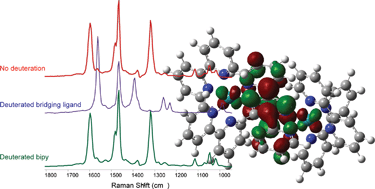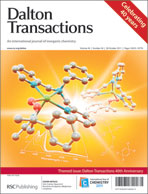Reinvestigating 2,5-di(pyridin-2-yl)pyrazine ruthenium complexes: selective deuteration and Raman spectroscopy as tools to probe ground and excited-state electronic structure in homo- and heterobimetallic complexes†
Abstract
The mono- (1) and dinuclear (2) ruthenium(II) bis(2,2′-bipyridine) complexes of 2,5-di(pyridin-2-yl)pyrazine (2,5-dpp), for which the UV/Vis absorption and emission as well as electrochemical properties have been described earlier, are reinvestigated here by resonance, surface enhanced and transient resonance Raman spectroscopy together with selective deuteration to determine the location of the lowest lying excited metal to ligand charge transfer (3MLCT) states. The ground state absorption spectrum of both the mono- and dinuclear complexes are characterised by resonance Raman spectroscopy. The effect of deuteration on emission lifetimes together with the absence of characteristic bipy anion radical modes in the transient Raman spectra for both the mono- and dinuclear complexes bridged by the 2,5-dpp ligand confirms that the excited state is 2,5-dpp based; however DFT calculations and the effect of deuteration on emission lifetimes indicate that the bipy based MLCT states contribute to excited state deactivation. Resonance Raman and surface enhanced Raman spectroscopic (SERS) data for 1 and 2 are compared with that of the heterobimetallic complexes [Ru(bipy)2(2,5-dpp)PdCl2]2+3 and [Ru(bipy)2(2,5-dpp)PtCl2]2+4. The SERS data for 1 indicates that a heterobimetallic Ru–Au complex forms in situ upon addition of 1 to a gold colloid.

- This article is part of the themed collection: Dalton Transactions 40th Anniversary

 Please wait while we load your content...
Please wait while we load your content...